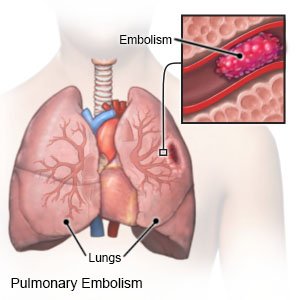Pulmonary Embolism
Medically reviewed by Drugs.com. Last updated on Sep 23, 2025.
A pulmonary embolism (PE) is the sudden blockage of a blood vessel in the lungs by an embolus. A PE can become life-threatening. Go to follow-up appointments and take blood thinners as directed. These are especially important if you were discharged home from the emergency department.
 |
WHILE YOU ARE HERE:
Informed consent
is a legal document that explains the tests, treatments, or procedures that you may need. Informed consent means you understand what will be done and can make decisions about what you want. You give your permission when you sign the consent form. You can have someone sign this form for you if you are not able to sign it. You have the right to understand your medical care in words you know. Before you sign the consent form, understand the risks and benefits of what will be done. Make sure all your questions are answered.
An IV
is a small tube placed in your vein that is used to give you medicine or liquids.
Medicines:
- Clot busters are emergency medicines that work to dissolve blood clots.
- Blood thinners help treat the PE. You may need this medicine if your PE was caused by part of a blood clot that broke off from a DVT. Blood thinners prevent new clots from forming. While you are taking warfarin or other blood thinners, you may bleed or bruise more easily.
Tests:
- Blood tests may show signs of the PE or how well your organs are working.
- An EKG test records your heart rhythm and how fast your heart beats. It is used to check for abnormal heart function.
- A chest x-ray may show signs of a lung infection or other damage.
- A CT scan may show the PE. You may be given contrast liquid to help your lungs show up better in the pictures. Tell the healthcare provider if you have ever had an allergic reaction to contrast liquid.
- A lung scan , or V/Q scan, may show how well blood and oxygen flow in your lungs. A small amount of contrast liquid is used to study your airflow (V) and blood flow (Q). First, you breathe in medical gas. Then, contrast liquid is injected into a vein. Pictures are taken to see how well your lungs take in oxygen.
- A pulmonary angiogram may show problems with blood flow in your heart and lungs. A catheter (long, thin, bendable tube) is placed in a vein in your neck, under your collarbone, or in your groin. The catheter is then threaded into the pulmonary artery. Contrast liquid is put into the catheter and x-rays are taken. The contrast liquid helps show your blood vessels clearly on the monitor. Tell a healthcare provider if you have ever had an allergic reaction to contrast liquid.
Treatment:
- You may need extra oxygen if your blood oxygen level is lower than it should be. You may get oxygen through a mask placed over your nose and mouth or through small tubes placed in your nostrils. Ask your healthcare provider before you take off the mask or oxygen tubing.
- Pneumatic boots or pressure stockings may be needed. The boots have an air pump that tightens and loosens different areas of the boots. The stockings are tight and put pressure on your legs. This improves blood flow and helps prevent clots.
- A vena cava filter may be placed inside your vena cava to prevent another PE. The vena cava is a large vein that brings blood from your lower body up to your heart. The filter may help trap an embolus and prevent it from going into your lungs.
- Surgery called a thrombectomy may be done to remove the PE. A procedure called thrombolysis may instead be done to inject a clot buster that helps dissolve or break the clot apart.
Treatment options
The following list of medications are related to or used in the treatment of this condition.
RISKS:
You have a higher risk for another PE. The blood clot may block the blood flow to your heart and lungs. You may bleed more than expected if you take blood thinners. Without treatment, the PE can cause your lungs and other body organs to stop working. This can be life-threatening.
CARE AGREEMENT:
You have the right to help plan your care. Learn about your health condition and how it may be treated. Discuss treatment options with your healthcare providers to decide what care you want to receive. You always have the right to refuse treatment.© Copyright Merative 2025 Information is for End User's use only and may not be sold, redistributed or otherwise used for commercial purposes.
The above information is an educational aid only. It is not intended as medical advice for individual conditions or treatments. Talk to your doctor, nurse or pharmacist before following any medical regimen to see if it is safe and effective for you.
Learn more about Pulmonary Embolism
Treatment options
Care guides
Further information
Always consult your healthcare provider to ensure the information displayed on this page applies to your personal circumstances.
